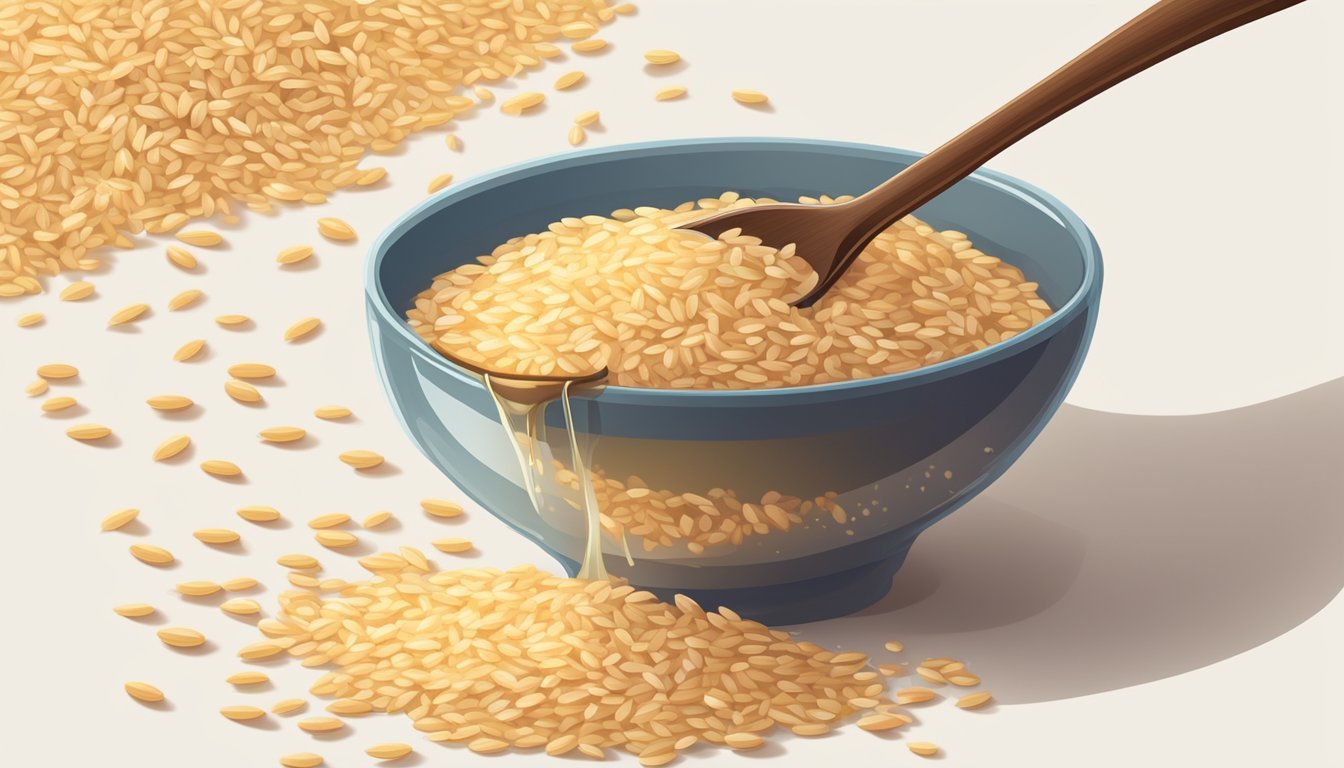Common Foods and Beverages High in Dextrose
Key Sources and Benefits
Dextrose is a simple sugar that is commonly used as a sweetener and preservative in numerous foods. Many foods, especially processed items, incorporate dextrose for its ability to enhance flavor and texture. Understanding which foods are high in dextrose can help individuals make informed dietary choices, manage blood sugar levels, and ensure balanced nutrition.
Derived primarily from corn, dextrose is a key ingredient in various baked goods, desserts, and beverages. Its role extends beyond just sweetening, as it is also used by athletes and bodybuilders for its quick energy release. Identifying food sources high in dextrose is essential for those seeking to regulate their intake of simple sugars.
1) Corn Syrup
Corn syrup is a sweetening agent derived from corn. It is a combination of different types of sugar, including dextrose and fructose. The process to create corn syrup involves treating cornstarch with acids and enzymes.
The presence of dextrose in corn syrup makes it a common ingredient in many processed foods. It is frequently used in baked goods, candies, and sodas due to its ability to enhance sweetness and moisture.
Aside from its role in sweetening, corn syrup acts as a preservative in some products. The dextrose in corn syrup inhibits mold and yeast growth, extending the shelf life of various foods.
Corn syrup is also found in fast foods and numerous snack items. Its liquid form makes it easy to mix into products, contributing to a smoother texture in items like ice cream and sauces.
Despite its widespread use, corn syrup offers little nutritional value. It mainly provides empty calories and lacks essential nutrients. This can contribute to health concerns when consumed in large amounts over time.
2) Honey
Honey is a natural sweetener produced by bees. It consists mostly of sugar, including dextrose. This can contribute to its sweet taste and impact on blood sugar levels.
Dextrose, also known as d-glucose, is one of the simple sugars found in honey. It is absorbed quickly by the body, providing a rapid source of energy.
In addition to dextrose, honey contains other sugars such as fructose and glucose. The composition can vary depending on the source of the nectar collected by bees.
People with specific dietary needs, such as those with diabetes, should be mindful of honey's sugar content. It affects blood sugar levels due to its combination of natural sugars.
Some studies suggest that honey consumption can help lower fasting blood sugar levels and triglycerides. However, its use should be balanced within an individual's total dietary intake.
Honey can be found in various culinary applications, from sweetening tea to flavoring desserts. Its natural origin and nutritional profile make it a popular choice among those looking to incorporate a more natural sweetener into their diet.
3) Maple Syrup
Maple syrup is a natural sweetener commonly used in culinary dishes and baking. It is derived by boiling sap from various species of the Acer tree, most commonly the sugar maple.
A tablespoon of pure maple syrup contains approximately 52 calories, 12 grams of sugar, and 13 grams of carbohydrates. These contents include natural sugars like sucrose, fructose, and glucose.
Maple syrup contains minerals such as calcium, potassium, iron, magnesium, manganese, and zinc. This makes it different from refined sugar, which lacks these nutritional benefits.
It also has a glycemic index estimated to be around 54, which is moderate. The glycemic index measures how quickly carbohydrates in food raise blood sugar levels.
Canada, particularly Quebec, is the leading producer of maple syrup, contributing about 71% of the world’s supply. Maple syrup is praised for its flavor and its use in both sweet and savory dishes.
4) Agave Nectar
Agave nectar is a popular alternative sweetener derived from the agave plant, primarily found in Mexico. It is often marketed as a healthier option compared to other sugars.
Agave nectar contains about 5 grams of carbohydrates and 20 calories per teaspoon. Its sweetness is higher than table sugar, allowing for smaller quantities to achieve the same level of sweetness.
One of the notable characteristics of agave nectar is its high fructose content, which can have varying effects on health. High fructose intake, when consumed in large amounts, can lead to negative health outcomes similar to those associated with high-sugar diets.
Despite its lower glycemic index, which means it has less impact on blood sugar levels compared to glucose, agave nectar's high fructose content should be considered. Foods with a lower glycemic index generally cause smaller fluctuations in blood sugar levels.
In terms of nutritional value, agave nectar has minimal benefits once processed. It lacks significant vitamins or minerals, providing primarily carbohydrates.
While agave nectar might be seen as a more natural sweetener, it is essential to use it in moderation due to its fructose content.
5) Golden Syrup
Golden syrup, a product made primarily in England, is a thick and amber-colored sweetener derived from cane sugar.
This syrup is widely recognized for its warm, caramel-like flavor. It is used extensively in various British desserts and occasionally in American speciality foods.
Although its nutritional profile closely matches that of table sugar, its distinctive taste makes it a preferred ingredient for many.
Golden syrup, while not commonly associated directly with dextrose, still contains a notable amount of this simple sugar.
It is consumed in moderation, much like other sugary products, due to its high calorie content.
When used in recipes, it adds not only sweetness but also a unique depth of flavor.
6) High Fructose Corn Syrup
High fructose corn syrup (HFCS) is a common sweetener made from corn starch. Introduced in the 1970s, it is widely used in the food and beverage industry. HFCS is a liquid composed of fructose and glucose, similar in composition and metabolism to other fructose-glucose sweeteners like sucrose, honey, and fruit juice concentrates.
HFCS is often found in processed foods and drinks. Examples include sodas, sweetened juices, candies, cakes, and cookies. Many processed desserts and baked goods also contain HFCS, making it a prevalent ingredient in many items found on grocery store shelves.
In addition to sweetening, HFCS plays a role in preserving food. It can extend the shelf life of products by inhibiting mold and yeast growth. Its usage is valued by manufacturers for its cost-effectiveness and ability to blend seamlessly into various formulations.
Despite its widespread use, HFCS has been a subject of debate. Some nutritional experts believe it may be linked to health issues, though its effects are similar to those of other fructose-glucose sweeteners. Its presence in a significant number of processed foods highlights the importance of reading ingredient labels for those looking to manage their sugar intake.
7) Confectioner's Glaze
Confectioner's glaze is often used by candy manufacturers to provide a shiny, smooth finish to their products. This glaze, also known as pharmaceutical glaze, is primarily composed of shellac.
Shellac is a resin secreted by the female lac bug and is harvested in countries like India and Thailand. Once collected, it is processed and purified before being applied to candies.
Although confectioner's glaze is technically edible, it is used sparingly due to its insect origin. Many consumers are unaware that their glossy candies owe their appearance to this natural resin.
The glaze helps prolong the shelf-life of candies by creating a moisture-resistant barrier. This prevents candies from becoming sticky or deteriorating quickly.
Products like jelly beans, candy-coated chocolates, and certain types of chewing gum frequently utilize confectioner’s glaze. This addition ensures the visual appeal and enhances the texture of the confections.
While confectioner's glaze is approved by many food safety authorities, those with dietary restrictions may prefer to avoid it. Its use in food products continues to be a point of interest for both manufacturers and consumers.
8) Fruit Juice Concentrate
Fruit juice concentrate is a common ingredient found in various beverages and food products. It is created by removing the majority of the water content from fruit juice, resulting in a dense, syrupy liquid. This process concentrates the natural sugars present in the juice, making it a significant source of dextrose.
Manufacturers often choose fruit juice concentrate because it offers a longer shelf life and is cost-effective. It is important to note that while fruit juice concentrate retains some of the vitamins and minerals from the original fruit, it also contains high levels of natural sugars.
Consuming large amounts of fruit juice concentrate can lead to an increase in blood sugar levels. This is particularly important for individuals managing diabetes or those monitoring their sugar intake. It's advisable to check product labels for fruit juice concentrates to be aware of sugar content.
Fruit juice concentrates are used in many products ranging from breakfast cereals to snacks and desserts. They add flavor and act as sweeteners, enhancing the taste of various foods. While they offer a convenient way to add fruit flavor, moderation is key to maintaining a healthy diet.
9) Molasses
Molasses is a byproduct of the sugar refining process, particularly from sugarcane or sugar beets. It’s known for its rich, robust flavor and dark color. Blackstrap molasses, a specific type, is notably more nutritious than regular molasses.
While molasses is not high in dextrose, it does contain a significant amount of other sugars, primarily glucose and fructose. One tablespoon of blackstrap molasses has about 10 grams of sugar and 14 grams of carbohydrates.
Molasses is also rich in essential minerals. One tablespoon provides notable amounts of calcium, iron, copper, manganese, and potassium. It is seen as a more nutrient-dense alternative to highly refined sugars.
People looking for ways to sweeten foods while adding some nutritional value might consider using molasses. It has been linked to health benefits such as lowering blood pressure due to its potassium content.
However, it should be used in moderation, especially for individuals with blood sugar concerns, as it does have a significant carbohydrate content. Molasses can add a unique flavor to dishes like baked goods, sauces, and marinades.
While not particularly high in dextrose, molasses offers a flavorful and nutrient-rich option within its category of sweeteners.
10) Brown Rice Syrup
Brown rice syrup is a popular sweetener used in various processed foods. It is derived from brown rice through enzymatic reaction and contains three main sugars: maltotriose, maltose, and glucose.
The glycemic index of brown rice syrup is exceptionally high at 98, meaning it causes rapid spikes in blood sugar levels.
Consumers often find brown rice syrup in energy bars, beverages, and desserts. It serves as a healthier alternative to high-fructose corn syrup in some products. However, due to its high glycemic index, it is important for individuals managing blood sugar to use it cautiously.
Understanding Dextrose
Dextrose, a simple sugar derived from corn, plays significant roles in various foods and medical applications. This section explores its definition, characteristics, and the differences between natural and refined forms.
Definition and Characteristics
Dextrose is a type of glucose, a monosaccharide that is a fundamental energy source for the body. Derived primarily from corn, it appears as a white, crystalline powder.
Due to its simple structure, dextrose rapidly increases blood sugar levels. This quick uptake makes it useful in medical treatments, especially for hypoglycemia and dehydration.
In the food industry, dextrose is prevalent in many processed items due to its sweet taste and ability to enhance product texture and shelf life.
Natural vs. Refined Dextrose
Natural Dextrose:
Natural sources of dextrose include fruits, honey, and some vegetables. These sources not only provide dextrose but also come with additional nutrients like fiber, vitamins, and minerals, which aid in a balanced diet.
Refined Dextrose:
Refined dextrose is processed from corn starch, stripped of its nutritional benefits, and added to numerous foods like candies, baked goods, and sodas.
While it enhances sweetness and preservation, excessive refined dextrose can lead to health issues such as weight gain and increased risk of diabetes. The lack of accompanying nutrients makes it important to monitor and moderate intake of refined dextrose.
Health Implications of Dextrose
Dextrose, which is derived from corn and used as a sweetener in many foods, carries both benefits and risks. Its effects depend largely on a person's health conditions and consumption levels.
Benefits of Dextrose
Dextrose is chemically identical to glucose, the body's primary source of energy. Due to this similarity, dextrose is commonly used in medical settings. It aids in treating low blood sugar (hypoglycemia) and dehydration by providing a quick source of energy. Intravenous solutions containing dextrose can rapidly elevate blood sugar levels in emergency situations, making them crucial for diabetic patients experiencing hypoglycemia.
Furthermore, dextrose is often used in sports and fitness regimes. It is known to quickly replenish glycogen stores, enhancing recovery and performance. This makes it a favorite among athletes for post-workout recovery. Additionally, dextrose is used in various processed foods to extend shelf life, as it inhibits mold and yeast growth, ensuring longer-lasting products.
Potential Risks of High Dextrose Intake
While dextrose offers several benefits, excessive consumption can pose significant health risks. Individuals with diabetes need to monitor their intake closely, as high doses can lead to spikes in blood sugar levels, worsening the condition. Over time, this can contribute to the development of insulin resistance and type 2 diabetes in individuals predisposed to the disease.
High dextrose consumption is also linked to weight gain and obesity. Foods high in dextrose are often calorie-dense and can lead to an excessive calorie intake, contributing to weight gain. Additionally, consuming large amounts of high-fructose corn syrup, a common source of dextrose, may increase the risk of metabolic disorders, such as non-alcoholic fatty liver disease (NAFLD) and cardiovascular disease.
In summary, while dextrose can be beneficial, especially in medical contexts and athletic recovery, its potential risks should not be overlooked. It's essential to consume it in moderation, considering the impact it can have on overall health.
Incorporating Dextrose-Rich Foods into Your Diet
Incorporating dextrose-rich foods into your diet can help provide a quick source of energy. This involves understanding dietary guidelines and ensuring you balance dextrose with other essential nutrients for optimal health.
Dietary Guidelines
When adding dextrose-rich foods to daily meals, it's crucial to consider moderation. Too much can lead to spikes in blood sugar levels. Foods high in dextrose include desserts like ice cream, cookies, and brownies.
Processed foods such as chips and soda are also common sources. Checking nutrition labels can help identify added sugars like dextrose.
Bodybuilders might use dextrose after workouts for energy replenishment. However, those with diabetes or insulin sensitivity should consult with a healthcare professional before making dietary changes.
Balancing Dextrose with Other Nutrients
To maintain a healthy diet, balance is key. Combining dextrose-rich foods with fiber-rich options can slow sugar absorption. Include foods like vegetables, whole grains, and legumes to improve overall nutrition.
Protein and healthy fats can also help stabilize blood sugar levels. Examples include lean meats, nuts, and avocados. These not only provide satiety but also essential nutrients, promoting a balanced diet.
Instead of consuming large amounts of dextrose in one sitting, spread consumption throughout the day. This approach helps avoid energy crashes and supports sustained energy levels. Pay attention to your body’s reactions and adjust intake as necessary.











